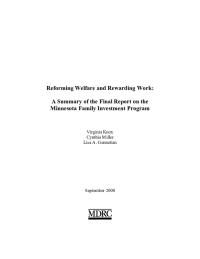Reforming Welfare and Rewarding Work: A Summary of the Final MFIP Report
The Minnesota Family Investment Program (MFIP) represents a new vision of welfare as a system that can simultaneously encourage work, reduce dependence on public assistance, and reduce poverty. It attempts to break loose from the historical tradeoffs among these goals by implementing two complementary policies: financial incentives to reward work and reduce poverty and, for long-term welfare recipients, mandatory participation in employment-focused services to encourage and require work and reduce dependence.
MFIP was initially implemented as a pilot program in the three urban counties of Hennepin (Minneapolis), Anoka, and Dakota, and the four rural counties of Mille Lacs, Morrison, Sherburne, and Todd. The pilot program operated from April 1994 to June 1998 and was evaluated by MDRC under contract to the Minnesota Department of Human Services. The evaluation was also supported by the agencies and foundations listed at the front of this summary. A modified version of MFIP is now Minnesota’s statewide welfare program.
This document summarizes the results presented in the evaluation’s final report. Volume 1 of that report examines MFIP’s effects on employment, earnings, welfare receipt, income, marriage, and other outcomes for adults in single- and two-parent families for up to three years after they entered the study. Volume 2 presents the results of a special study of MFIP’s effects on children and other aspects of family well-being for single mothers who had at least one child aged 2 to 9 when they entered the study.
MFIP’s results are particularly important because more than 40 states have incorporated a “make work pay” approach in conjunction with work requirements as part of their new, time-limited welfare reforms, which followed enactment of the 1996 federal Personal Responsibility and Work Opportunities Reconciliation Act (PRWORA). Most commonly — as in MFIP — states have aimed to make work pay by increasing their “earned income disregard”: More of a family’s earnings are disregarded (not counted) when their welfare grant is calculated. This policy allows more people to combine work and welfare. As discussed later, MFIP also included other financial incentives to work. The MFIP pilot program did not include time limits on welfare receipt, but the newer, statewide version does.
The evaluation results speak directly to three goals that have emerged as high priorities under PRWORA: ensuring that long-term welfare recipients make substantial strides toward self-sufficiency before reaching their time limits on welfare receipt, supporting the efforts of low-income workers to advance in their jobs and provide adequately for their families, and assuring that social policies do not discourage marriage.
To assess MFIP’s success in achieving its ambitious goals, the evaluation used a rigorous, random assignment research design. Between April 1994 and March 1996, more than 14,000 families in seven Minnesota counties were assigned, using a lottery-like process, to either the MFIP program (the “MFIP group”) or the traditional Aid to Families with Dependent Children (AFDC) program (the “AFDC group”). MFIP’s effects were estimated by following the two groups over time and comparing their employment, welfare receipt, and other outcomes. The difference in outcomes between the two groups is the effect, or impact, of the MFIP program.






